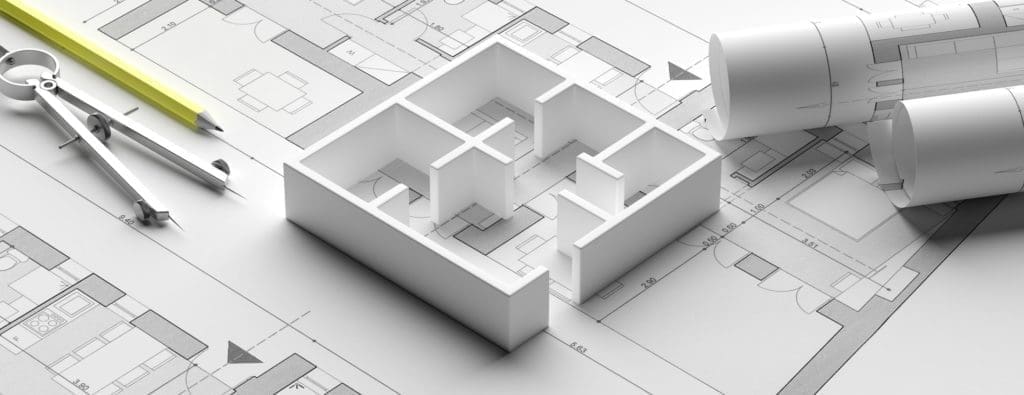
Architectural Technology
Get started today
Architectural Technology
The profession of architecture touches everyone’s life and is central to solving problems in the creation of a built environment. Architectural technicians are problem solvers who work with clients on the design of buildings. They also create plans and specifications that direct the construction of a building and coordinate the work of other professional consultants and engineers. Managing information and responding to the many diverse requirements of governments, building conditions, and society is increasingly important in the construction industry. The architectural profession is rapidly integrating the technology of computers and automation to assist in the management of information and to free up time for creative work.
The instruction in Architectural Technology at Thaddeus Stevens College prepares students to become qualified for employment in the architectural profession and to transfer into architectural programs in nationally-accredited universities. The instruction also provides retraining in technological applications for people currently employed in or reentering the profession.
High school prerequisites for this program are Algebra I & II and a GPA of at least 2.5.
What you’ll learn
- Demonstrate technical proficiency in utilizing industry-standard software and tools for architectural design.
- Apply architectural design principles and methodologies efficiently to create innovative and functional solutions.
- Understand fundamental construction materials, methods, building systems and structural principles applicable to architectural projects.
- Interpret and apply relevant building codes, zoning regulations, and accessibility standards within the architectural design processes.
- Develop communication skills through visual, written, and oral means, producing comprehensive architectural documentation and presentations suitable for various stakeholders.
- Collaborate effectively within multidisciplinary teams, demonstrating the ability to contribute constructively to project planning, design, and implementation.
- Apply problem-solving, critical-thinking, and mathematical reasoning to analyze architectural challenges, propose creative solutions, and make informed design decisions efficiently.
- Understand ethical responsibilities, professional standards, and the societal impact of architectural decisions.
- Demonstrate the ability to manage projects effectively, optimizing time allocation from conceptualization to execution, considering scheduling and regulatory constraints.
- Engage in lifelong learning, keeping pace with technological advancements, industry trends, and sustainable practices to enhance productivity within the field of architectural technology.
Sample Job Titles
CAD (Computer-Aided Design) Technician, BIM (Building Information Modeling) Technician, Design Professional, Project Manager, Facility Designer, VDC (Virtual Design and Construction) Technician
Soar Agreement
This program enables students to apply certain credits earned in high school to the credits needed for a degree or certificate through Thaddeus Stevens College. The Architectural Technology degree qualifies for this program – see our SOAR program page for details!
Quick facts
Location
Griscom Education Center, First floor (above lobby level)
Type of program
Associate Degree
Job/Salary Outlook
See industry data
Length of program
2 years, 73 credits
Cost of program
$4,500/semester tuition
$3,000 – $3,500/semester housing
$1,850 – $2,335/semester meal plan
Tool List: First-year students, Second-year students (PDF)
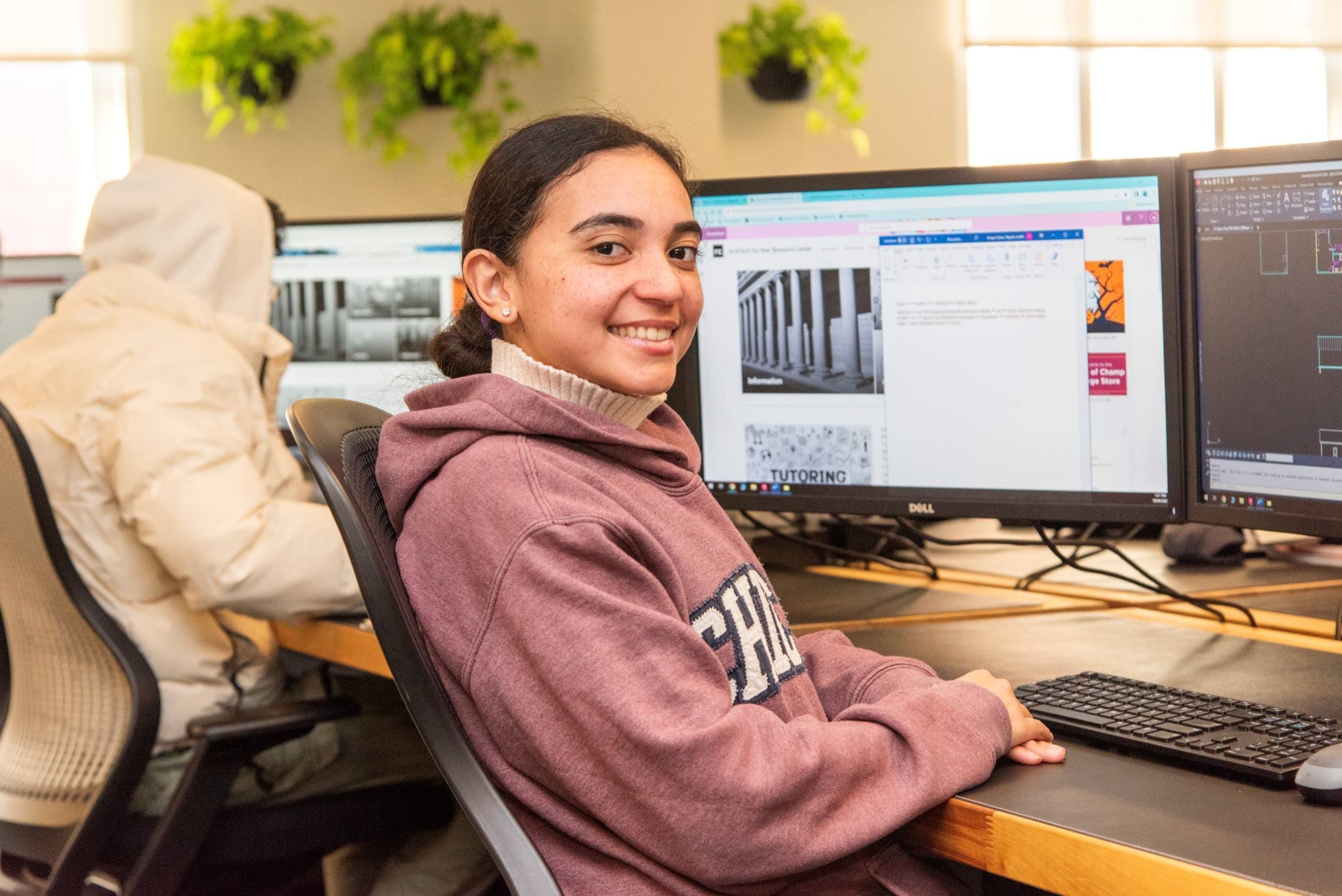
The outcomes speak for themselves
Graduates of this program work in the Architectural, Engineering, and Construction (AEC) industry and can also transfer into programs in nationally accredited universities.
88%
employment
$50.5K
med. salary
People of TSCT
Success stories
Program details
Courses
MODEL SCHEDULE FOR ARCHITECTURAL TECHNOLOGY
Semester 1
- ARCH 106 – Fundamentals of Architectural Technology (3 credits)
- ARCH 111 – Materials of Construction (3 credits)
- ARCH 124 – CAD in Architecture (3 credits)
- ARCH 157 – Construction Specifications (3 credits)
- MATH 137 – Intermediate Algebra (or higher) (3 credits)
- CIS 111 – Intro to Computer Applications (3 credits)
Semester 2
- ARCH 116 – Residential Details (3 credits)
- ARCH 162 – Working Drawings (3 credits)
- ARCH 167 – Rendering and Illustration (3 credits)
- ARCH 172 – Advanced CAD in Architecture (3 credits)
- MATH 141 – Trigonometry* (or higher) (3 credits)
- ENG 106 – English Composition (3 credits)
Semester 3
- ARCH 207 – Advanced Materials of Construction (3 credits)
- ARCH 212 – Structural Systems (3 credits)
- ARCH 216 – Site and Microclimate Design (3 credits)
- ARCH 262 – Life Safety and Building Codes (3 credits)
- PHYS 113 – Statics (3 credits)
- ENG 216 – Technical Writing* (3 credits)
Semester 4
- ARCH 257 – Environmental Systems (3 credits)
- ARCH 267 – Architectural History (3 credits)
- ARCH 272 – Individual Design Studio (3 credits)
- ARCH 276 – Group Design Studio (3 credits)
- Humanities Elective (3 credits)
Additional General Education Requirements
- HEAL Elective HEAL 106 or HEAL 111 (1 credits)
- Elective General Studies Elective (3 credits)
Total Credits 73
*Subject to Pre-requisite. Please see Catalog.
Faculty
Occupational Advisory Committee
The Occupational Advisory Committee (OAC) serves as a vital link between the Program of study and industry, ensuring that the program remains aligned with current workforce needs, technological advancements, and best practices in the field. Composed of employers, educators, and other community members, the committee provides guidance, feedback, and recommendations to enhance the curriculum, instructional methods, and student learning experiences.
Purpose and Responsibilities:
- Curriculum & Industry Alignment
- Workforce Readiness
- Student & Faculty Support
- Internship & Employment Connections
- Accreditation & Program Evaluation
- Facilities & Equipment Recommendations
By fostering a strong relationship between academia and industry, the OAC helps ensure that Thaddeus Stevens College programs maintain the highest standards in CTE (career and technical education).
- Monica Abreu-Adames, Wohlsen Construction
- Gretchen Berkheimer, Providence Engineering
- Jim Kelley, Armstrong World Industries
- Glenn Ebersole, PM Design Group, Inc.
- Carl Kowalski, Marotta/Main Architects
- Justin Martin, RLPS
- Douglas Phillips, Douglas Charles Phillips Architect
- Krista Riley, Clark Food Service Equipment
- Brad Zahm, Garman Builders
Essential Skills Learned
Prepare detailed drawings of architectural and structural features of buildings or drawings and topographical relief maps used in civil engineering projects, such as highways, bridges, and public works. Use knowledge of building materials, engineering practices, and mathematics to complete drawings.
Tasks
- Produce drawings, using computer-assisted drafting systems (CAD) or drafting machines, or by hand, using compasses, dividers, protractors, triangles, and other drafting devices.
- Draft plans and detailed drawings for structures, installations, and construction projects, such as highways, sewage disposal systems, and dikes, working from sketches or notes.
- Coordinate structural, electrical, and mechanical designs and determine a method of presentation to graphically represent building plans.
- Analyze building codes, by-laws, space and site requirements, and other technical documents and reports to determine their effect on architectural designs.
- Draw maps, diagrams, and profiles, using cross-sections and surveys, to represent elevations, topographical contours, subsurface formations, and structures.
- Layout and plan interior room arrangements for commercial buildings, using computer-assisted drafting (CAD) equipment and software.
- Supervise and train other technologists, technicians, and drafters.
- Determine the order of work and method of presentation, such as orthographic or isometric drawing.
- Finish and duplicate drawings and documentation packages according to required mediums and specifications for reproduction, using blueprinting, photography, or other duplicating methods.
- Draw rough and detailed scale plans for foundations, buildings, and structures, based on preliminary concepts, sketches, engineering calculations, specification sheets, and other data.
Tools used in this occupation
- Curves — Flexible curves; French curves
- Graphics or video accelerator cards — Computer-aided design CAD multi-unit display graphics cards
- Scales — Architects’ scales; Electronic scales
- Scanners — Backlit digitizers; Sonic digitizers; Three-dimensional laser digitizers; Wide-format document scanners
- Tablet computers — Graphics tablets; Pressure-sensitive graphic tablets
Technology used in this occupation
- Computer-aided design CAD software — Autodesk AutoCAD Civil 3D; Autodesk Revit; Bentley MicroStation; Trimble SketchUp Pro
- Development environment software — Adobe Systems Adobe Creative Suite; C; Microsoft .NET Framework
- Graphics or photo imaging software — Adobe Systems Adobe Illustrator; Adobe Systems Adobe Photoshop; Corel Paint Shop Pro; Microsoft Visio
- Map creation software — ESRI ArcGIS software; ESRI ArcView; Geomechanical design analysis GDA software; Topographic map software
- Presentation software — Microsoft PowerPoint
Knowledge
- Design — Knowledge of design techniques, tools, and principles involved in production of precision technical plans, blueprints, drawings, and models.
- Building and Construction — Knowledge of materials, methods, and the tools involved in the construction or repair of houses, buildings, or other structures such as highways and roads.
- Engineering and Technology — Knowledge of the practical application of engineering science and technology. This includes applying principles, techniques, procedures, and equipment to the design and production of various goods and services.
- Computers and Electronics — Knowledge of circuit boards, processors, chips, electronic equipment, and computer hardware and software, including applications and programming.
- English Language — Knowledge of the structure and content of the English language including the meaning and spelling of words, rules of composition, and grammar.
- Mathematics — Knowledge of arithmetic, algebra, geometry, calculus, statistics, and their applications.
- Public Safety and Security — Knowledge of relevant equipment, policies, procedures, and strategies to promote effective local, state, or national security operations for the protection of people, data, property, and institutions.
- Administration and Management — Knowledge of business and management principles involved in strategic planning, resource allocation, human resources modeling, leadership technique, production methods, and coordination of people and resources.
- Customer and Personal Service — Knowledge of principles and processes for providing customer and personal services. This includes customer needs assessment, meeting quality standards for services, and evaluation of customer satisfaction.
Skills
- Active Listening — Giving full attention to what other people are saying, taking time to understand the points being made, asking questions as appropriate, and not interrupting at inappropriate times.
- Critical Thinking — Using logic and reasoning to identify the strengths and weaknesses of alternative solutions, conclusions or approaches to problems.
- Reading Comprehension — Understanding written sentences and paragraphs in work related documents.
- Speaking — Talking to others to convey information effectively.
- Writing — Communicating effectively in writing as appropriate for the needs of the audience.
- Complex Problem Solving — Identifying complex problems and reviewing related information to develop and evaluate options and implement solutions.
- Judgment and Decision Making — Considering the relative costs and benefits of potential actions to choose the most appropriate one.
- Systems Analysis — Determining how a system should work and how changes in conditions, operations, and the environment will affect outcomes.
- Active Learning — Understanding the implications of new information for both current and future problem-solving and decision-making.
- Mathematics — Using mathematics to solve problems.
- Monitoring — Monitoring/Assessing performance of yourself, other individuals, or organizations to make improvements or take corrective action.
- Time Management — Managing one’s own time and the time of others.
Abilities
- Near Vision — The ability to see details at close range (within a few feet of the observer).
- Oral Comprehension — The ability to listen to and understand information and ideas presented through spoken words and sentences.
- Written Comprehension — The ability to read and understand information and ideas presented in writing.
- Oral Expression — The ability to communicate information and ideas in speaking so others will understand.
- Problem Sensitivity — The ability to tell when something is wrong or is likely to go wrong. It does not involve solving the problem, only recognizing there is a problem.
- Information Ordering — The ability to arrange things or actions in a certain order or pattern according to a specific rule or set of rules (e.g., patterns of numbers, letters, words, pictures, mathematical operations).
- Visualization — The ability to imagine how something will look after it is moved around or when its parts are moved or rearranged.
- Deductive Reasoning — The ability to apply general rules to specific problems to produce answers that make sense.
- Written Expression — The ability to communicate information and ideas in writing so others will understand.
- Inductive Reasoning — The ability to combine pieces of information to form general rules or conclusions (includes finding a relationship among seemingly unrelated events).
- Speech Clarity — The ability to speak clearly so others can understand you.
- Flexibility of Closure — The ability to identify or detect a known pattern (a figure, object, word, or sound) that is hidden in other distracting material.
Work Activities
- Interacting With Computers — Using computers and computer systems (including hardware and software) to program, write software, set up functions, enter data, or process information.
- Drafting, Laying Out, and Specifying Technical Devices, Parts, and Equipment — Providing documentation, detailed instructions, drawings, or specifications to tell others about how devices, parts, equipment, or structures are to be fabricated, constructed, assembled, modified, maintained, or used.
- Getting Information — Observing, receiving, and otherwise obtaining information from all relevant sources.
- Evaluating Information to Determine Compliance with Standards — Using relevant information and individual judgment to determine whether events or processes comply with laws, regulations, or standards.
- Making Decisions and Solving Problems — Analyzing information and evaluating results to choose the best solution and solve problems.
- Communicating with Supervisors, Peers, or Subordinates — Providing information to supervisors, co-workers, and subordinates by telephone, in written form, e-mail, or in person.
- Thinking Creatively — Developing, designing, or creating new applications, ideas, relationships, systems, or products, including artistic contributions.
Work Context
- Electronic Mail — How often do you use electronic mail in this job?
- Face-to-Face Discussions — How often do you have to have face-to-face discussions with individuals or teams in this job?
- Indoors, Environmentally Controlled — How often does this job require working indoors in environmentally controlled conditions?
- Importance of Being Exact or Accurate — How important is being very exact or highly accurate in performing this job?
- Spend Time Sitting — How much does this job require sitting?
- Telephone — How often do you have telephone conversations in this job?
- Work With Work Group or Team — How important is it to work with others in a group or team in this job?
- Time Pressure — How often does this job require the worker to meet strict deadlines?
- Contact With Others — How much does this job require the worker to be in contact with others (face-to-face, by telephone, or otherwise) in order to perform it?
- Coordinate or Lead Others — How important is it to coordinate or lead others in accomplishing work activities in this job?
- Freedom to Make Decisions — How much decision-making freedom, without supervision, does the job offer?
- Importance of Repeating Same Tasks — How important is repeating the same physical activities (e.g., key entry) or mental activities (e.g., checking entries in a ledger) over and over, without stopping, to performing this job?
Interests
- Realistic— Realistic occupations frequently involve work activities that include practical, hands-on problems and solutions. They often deal with plants, animals, and real-world materials like wood, tools, and machinery. Many of the occupations require working outside, and do not involve a lot of paperwork or working closely with others.
- Conventional— Conventional occupations frequently involve following set procedures and routines. These occupations can include working with data and details more than with ideas. Usually, there is a clear line of authority to follow.
- Artistic— Artistic occupations frequently involve working with forms, designs, and patterns. They often require self-expression and the work can be done without following a clear set of rules.
- Investigative— Investigative occupations frequently involve working with ideas and require an extensive amount of thinking. These occupations can involve searching for facts and figuring out problems mentally.
Work Styles
- Attention to Detail — Job requires being careful about detail and thorough in completing work tasks.
- Dependability — Job requires being reliable, responsible, and dependable, and fulfilling obligations.
- Cooperation — Job requires being pleasant with others on the job and displaying a good-natured, cooperative attitude.
- Analytical Thinking — Job requires analyzing information and using logic to address work-related issues and problems.
- Adaptability/Flexibility — Job requires being open to change (positive or negative) and to considerable variety in the workplace.
- Independence — Job requires developing one’s own ways of doing things, guiding oneself with little or no supervision, and depending on oneself to get things done.
Work Values
- Support — Occupations that satisfy this work value offer supportive management that stands behind employees. Corresponding needs are Company Policies, Supervision: Human Relations and Supervision: Technical.
- Working Conditions — Occupations that satisfy this work value offer job security and good working conditions. Corresponding needs are Activity, Compensation, Independence, Security, Variety, and Working Conditions.
- Achievement — Occupations that satisfy this work value are results-oriented and allow employees to use their strongest abilities, giving them a feeling of accomplishment. Corresponding needs are Ability Utilization and Achievement.
Performance Measures
Internal Key Performance Indicators (Sources: Internal data collections, and Post-Graduate Surveys)
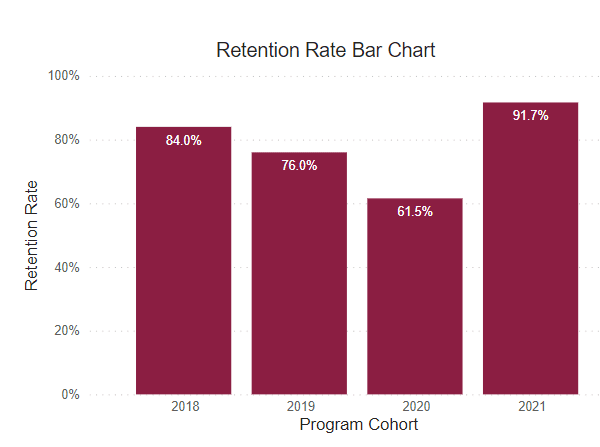
Retention Rate
This rate reflects the continuous term-to-term persistence rate for certificate programs and the fall-to-fall retention rate for associate degree programs.
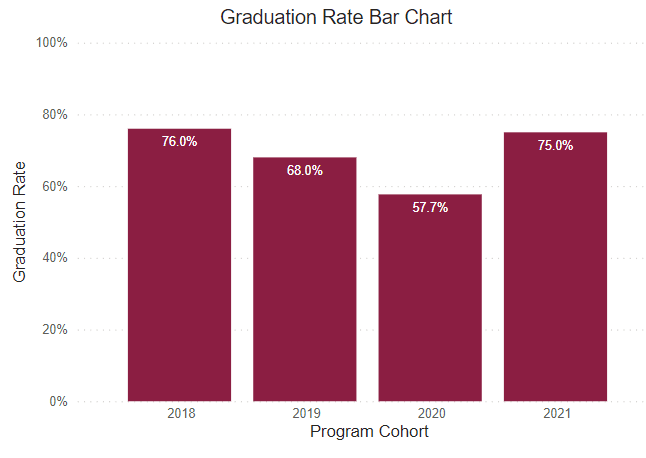
Graduation Rate
This rate reflects the number of freshmen who were officially enrolled in the fall semester and earned a certificate or degree within the expected timeframe.
Post Graduate Survey Response Rate
The post graduate survey is an annual on-line post graduate survey utilized by the college to gather vital information regarding career placement, starting salary, and level of satisfaction.
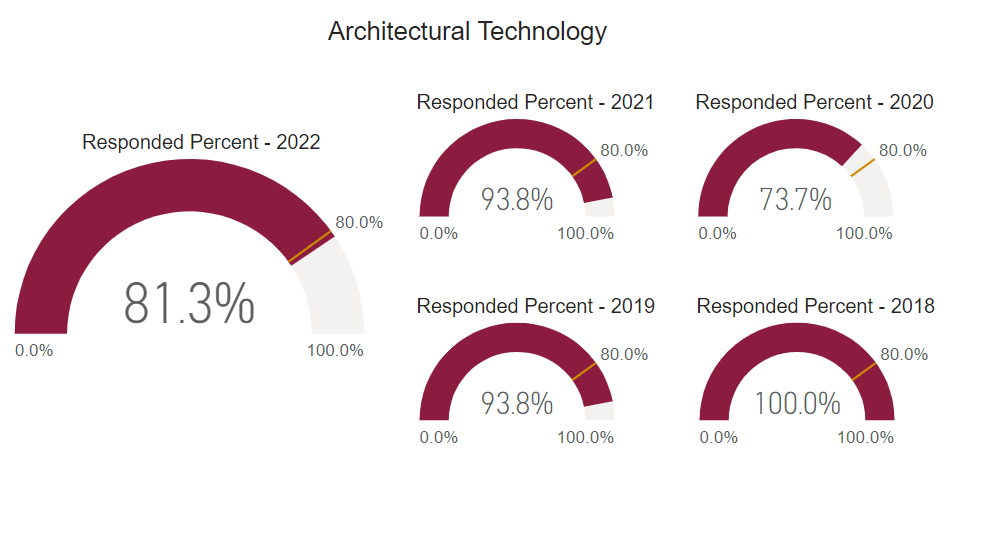
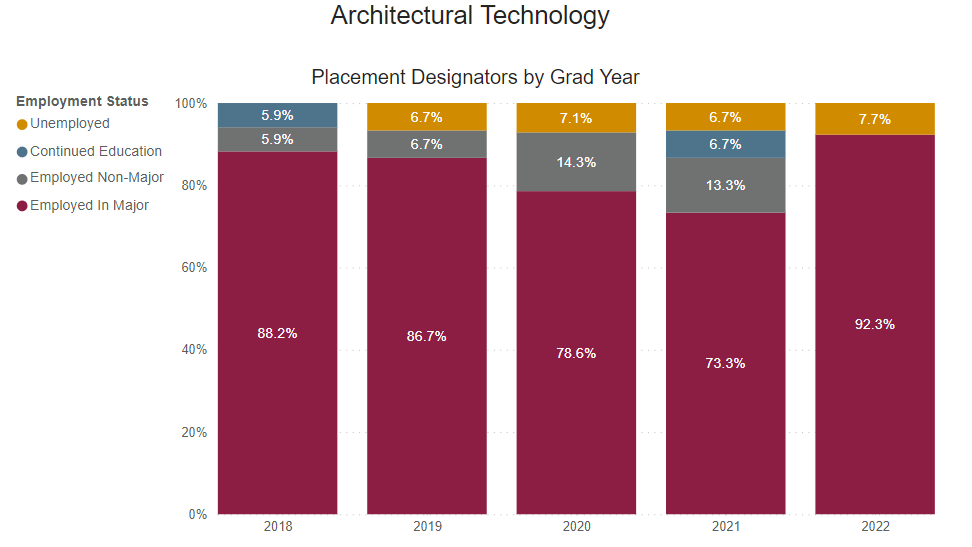
Employed Full Time Outside of Major
Percentage of graduates who reported being employed full-time outside their field of study.
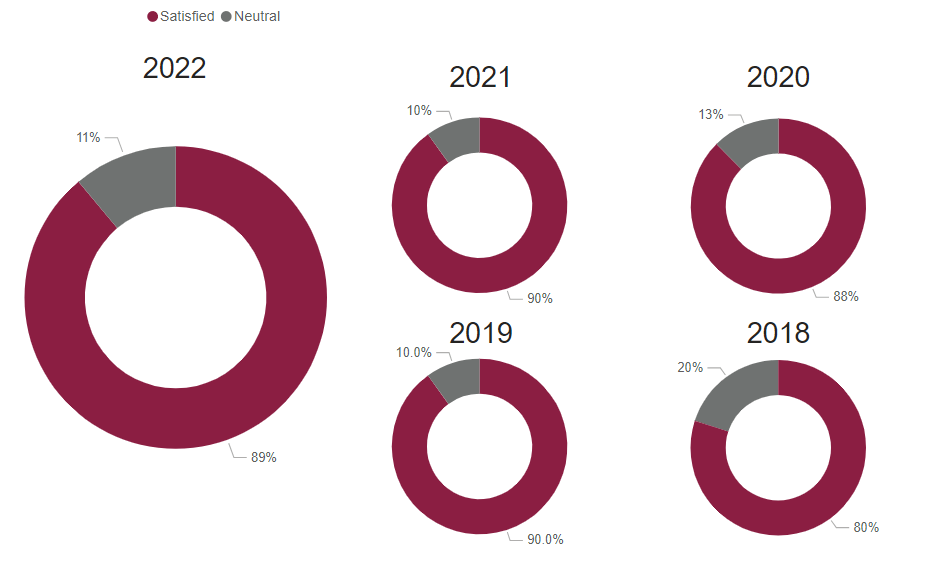
Graduate Satisfaction
This is the median graduate survey response evaluating the level of preparation for workforce entry (based on a 5-Item Likert Scale).
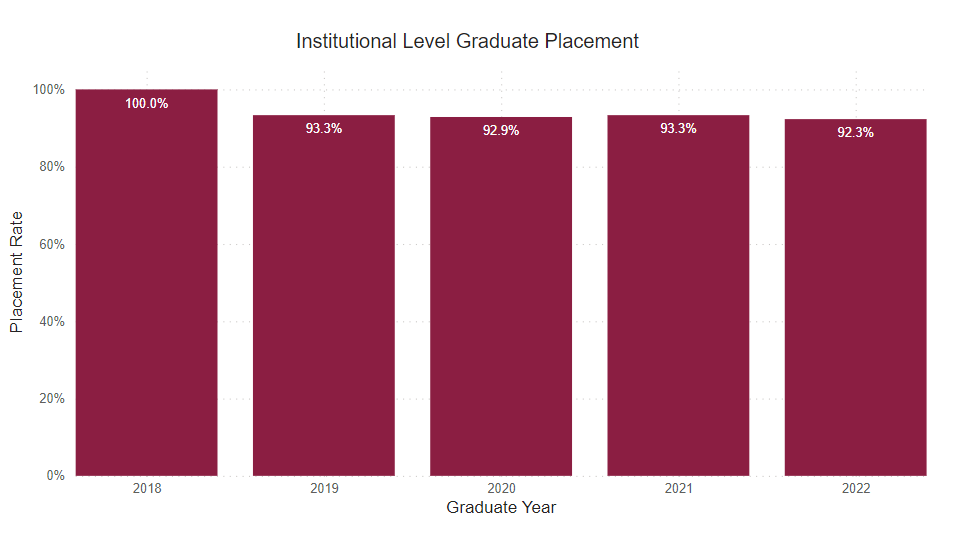
Placement Rate
This is the percent of graduate survey respondents who reported being employed or continued their education on a full-time basis.
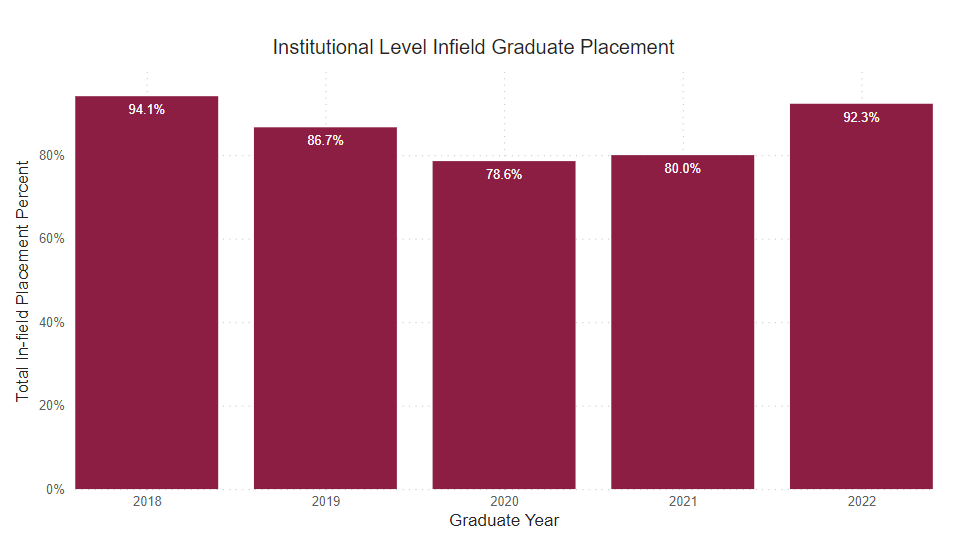
Employed Full Time Within Major
Percentage of graduates who reported being employed full-time within their field of study.
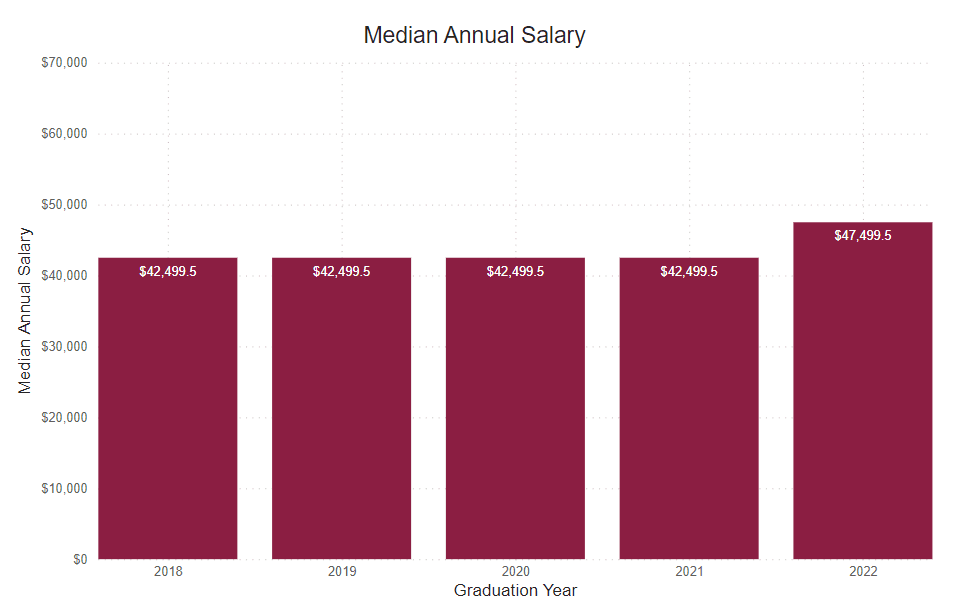
Annual Median Starting Salary
This number is based on the graduate survey response to the request to identify a starting salary from a range of options. This graph shows the median first-year annual salary. All calculations are based on the respondent’s self-reported first-year annual income.
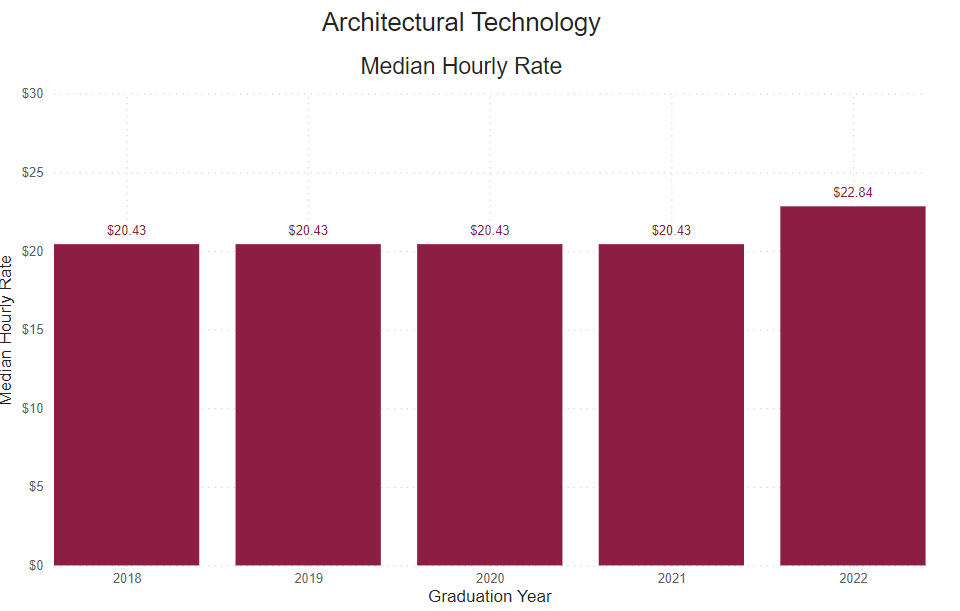
Reported Hourly Rate
This number is determined by dividing the reported median salary by the number of hours in a traditional full-time work week (40), then the number of weeks in a year (52).

Our graduates work with the industry’s best
